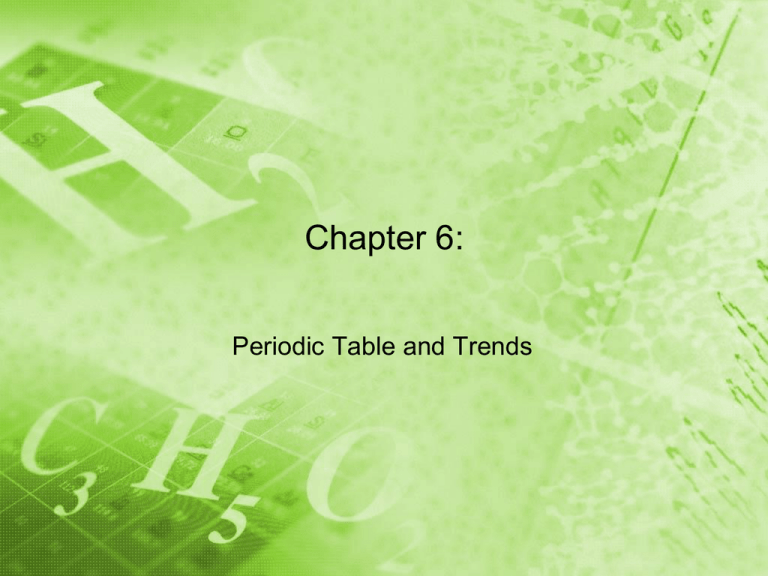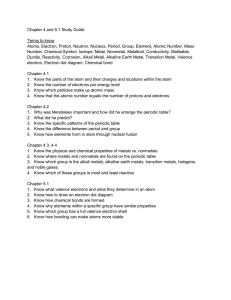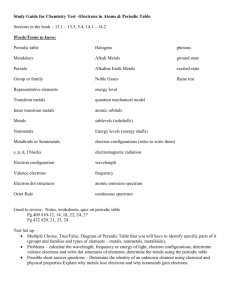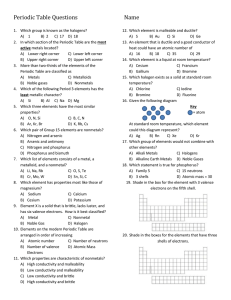Periodic Table and Trends
advertisement

Chapter 6: Periodic Table and Trends Dmitri Mendeleev • First Periodic Table • Based on increasing Atomic mass and repeating properties of elements • Had spaces for “missing” elements that he predicted Henry G. J. Moseley • Discovered that elements’ properties were more closely associated with atomic number • Modern periodic table is based on this discovery Periodic Law • When elements are arranged in order of increasing atomic number, their physical and chemical properties show a periodic pattern Reading the Periodic Table Inner or Groups Transition Nitrogen Alkaline Oxygen Carbon Boron Noble Alkali Halogens Periods Metals Family Gases Transition Earth Families Family Metals Metals Metals Metals • Left of the stairstep line • Majority of the elements • Tend to LOSE electrons • Most reactive in the s-block Properties of Metals • • • • • • Shiny luster Good conductors of heat Good conductors of electricity Most are solids at room temperature Malleable Ductile gold lead copper nickel Nonmetals • Right of Stair-Step line • Tend to GAIN electrons • Most reactive group is halogens • Least reactive group is Noble Gases Properties of Nonmetals • • • • • Dull Luster Poor conductors of heat Poor conductors of electricity Brittle Many are gases at room temperature CARBON BROMINE SULFUR ARGON Metalloids • Along Stair-step line • Have properties of metals AND nonmetals • Many are used in transistors, found in electronics Silicon Antimony Boron Alkali Metals • Group 1 (Except H) • All have only 1 valence electron • Most reactive metals; never found in elemental form in nature • Soft and shiny • Relatively low melting points Alkaline Earth Metals • Group 2 • All have 2 valence electrons • Second most reactive metals; never found in pure state in nature • Harder, denser, and stronger than alkali metals • Have higher melting points than alkali metals Transition Metals • Groups 3-12 • All have 1 or 2 valence electrons (in s sublevels) • Do not fit into any other group or family • Have many irregularities in their electron configurations Boron Family • • • • Group 3A Have 3 valence electrons Boron is a metalloid All others are metals Carbon Family • • • • • Group 4A All have 4 valence electrons Carbon is a nonmetal Si and Ge are metalloids Sn and Pb are metals Nitrogen Family • Group 5A • All have 5 valence electrons (s and p sublevels) • N and P are nonmetals • As and Sb are metalloids • Bi is a metal Oxygen Family • Group 6A • All have 6 valence electrons • Oxygen, Sulfur, and Selenium are nonmetals • Tellurium and Polonium are metalloids Halogens • • • • • Means “salt former” Group 7A All have 7 valence electrons Most reactive nonmetals All are nonmetals Noble Gases • Group 8A • 8 Valence electrons makes a full electron shell: s2 p6 • Complete, stable electron configuration (Complete outer energy level) • Least reactive of all elements Rare Earth Elements (Inner Transition metals) • • • • • Found in 2 rows at bottom of periodic table Lanthanide series follows La Actinide series follows Ac Little variation in properties Actinides are radioactive; only first three and Pu are found in nature Summary • Groups: Up and Down • Periods: Across • Main Group Elements are in groups 1-2, 1318 • Elements along the stair step line are metalloids • Elements to the left of the stair step line are metals • Elements to the right of the stair step line are nonmetals Octet Rule “Noble Gas Envy” • Atoms tend to gain, lose, or share electrons in order to acquire a full set of valence electrons (typically 8) Periodicity • Properties of the elements change in a predictable way as you move through the periodic table • These properties include • Atomic Radius • Ionization energy • Electronegativity Atomic Radius • Distance from nucleus to outermost valence electrons Atomic Radius • Increases down groups • Decreases from left to right Ionization Energy • The energy needed to remove 1 of an atom’s electrons • Decreases as you move down a group • Increases from left to right, across a period • Successive ionization energies increase for every electron removed 1st ionization energy Electronegativity • Reflects an atom’s ability to attract electrons in a chemical bond • Related to its ionization energy and electron affinity • Increases from left to right, across a period • Decreases from top to bottom, down a group Shielding • Shielding electrons are electrons located between the nucleus and the valence electrons • For example: • Chlorine has the following electron configuration: 1s2 2s2 2p6 3s2 3p5 • The shielding electrons would be 1s2 2s2 2p6 • The valence electrons would be 3s2 3p5 • Then we have 10 shielding electrons and 7 valence electrons, right? Shielding • You try one • Try Sodium (Na)… Remember, first you have to know the electron configuration • Did you get: • • • • Electron configuration: 1s2 2s2 2p6 3s1 Shielding electrons: 1s2 2s2 2p6 Valence electrons: 3s1 So we have 10 shielding electrons and 1 valence electron, right? Zeff • Effective nuclear charge (Zeff) is the charge felt by the valence electrons after you’ve taken into account the number of shielding electrons that surround the nucleus. • Huh? • Let’s put it in an equation • Zeff =# of protons - # of shielding electrons • So, calculate the effective nuclear charge for the all the elements in period 3 • Now, calculate the effective nuclear charge for all the elements in group 2 • What pattern do you see arising? • What is the correlation between Zeff and atomic radius? (Remember opposite charges attract) • The greater the Zeff the smaller the atomic radius • I’m still lost….. • Greater effective nuclear charge means that the valence electrons are feeling a greater pull toward the nucleus, making the atom smaller in size In summary… • Effective nuclear charge can be used to predict trends in atomic radius • Increases from left to right and decreases from top to bottom • Zeff = Z - σ • Effective nuclear charge is dependent upon electron shielding • Electronegativity increases from left to right and decreases from top to bottom






